|
THE WORKFORCE
While the Gasworks was in course of construction, much other work
was proceeding in the background to do with setting up the Company,
organising its day-to-day administration and deciding on what price
to charge for gas, especially to large consumers. While it is beyond
the scope of this account to set out details of the Company’s
workforce during the century covered by its Minute Books,
some mention of the Company organisation during its
early years is appropriate.
THE BOARD: at
Shareholder and Director meetings held on the 25th April, 1850, the
various positions required for the administration of the new Company
were filled by election, namely Thomas Butcher and John Brown,
Trustees; Messrs. H. S. Rowbotham, Frederick Butcher, William
Brown, Edward Pope and Joseph Gurney, Directors; William
Brown, Chairman of Directors and Edward Pope, Vice
Chairman; John Chapman and Thomas Woodman, Auditors;
Thomas Butcher, Treasurer; Messrs Butcher and Son, Bankers;
and A. T. Parkes, Secretary, at the time the only remunerated
officer of the Company at a salary of £12 p.a.
Board members came and went over the years, and until the Company
was sold in 1930, most were well known local businessmen. Among
their number William Brown (auctioneer and land surveyor), George
Butcher (of the Tring banking family), Walter Mead (butcher and farmer)
and John Clement (watch and clock maker) each, in their turn, chaired
the Board for many years.
COMPANY SECRETARY:
the first Secretary to be appointed was Alexander Thomas Parkes,
agent of the Tring Park Estate. He was described in his
obituary (Bucks Herald, 15th September 1888) as “excellent
man of business, kind in all relations of life, just, methodical,
and great worker.” Parkes was succeeded by Frederick Gotto
who remained in post until May 1861, when he was succeeded by John
Amsden at a salary of £30 p.a. At the Board meeting for that
month the directors resolved “that he be required to enter into a
bond jointly with a respectable person in the sum of £150,” a
large sum for the time. Whether this requirement had applied
to earlier Secretaries or, if not, why it should apply to Amsden,
isn’t recorded. The Minute Book also lists the duties that
Amsden was required to perform:
To make the returns required by the Act of Parliament;
To register all shares the parties themselves paying for the stamp
and transfer fees;
To inspect meters, and register gas consumed whenever required by
the Board to do so;
To collect rents quarterly and pay wages to Manager at Works weekly;
To visit the Works not less seldom than six times per week on an
average [his predecessor was required to visit once a week];
To examine the Manager’s petty cash acct and to receive monies for
coke, tar, etc weekly;
To examine all accounts, send notices of meetings and undertake all
correspondence;
Travelling expenses, postages, stationery etc. etc. to be provided
and paid for by the Company.
When the various monies in the hands of the Secretary reach £15, £10
is to be paid into the bank.
|
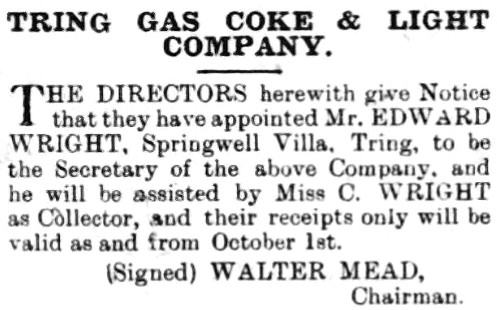 |
|
Bucks Herald, 29th
September1917. |
Amsden was to remain in post until August, 1888, when he was taken
seriously ill, dying in June of the following year. His
obituary writer described him as:
“ . . . . one of the best known men in Tring, where he was born
and had always lived. For a number of years he was Secretary of the
Gas Company, and a collector of rates, positions in which his
integrity was highly appreciated . . . . He was formerly engaged in
the [straw] plait trade, and latterly did some business as a
coal merchant. He was a man of good ability and of business
capacity, and no man in Tring, probably, knew more of its general
affairs for the last half century.”
Bucks
Herald, 22nd June 1889
WORKS MANAGER:
the first Works Manager was David Pike, appointed in January 1851 at
a wage of 16 shillings a week; he was “also to have the privilege
of putting in fittings to consumers on his own account . . . . It
was also resolved that one man be employed under Pike during the
winter months at 10s. per week wages,” the long nights of the
winter months being those in which consumption of gas was likely to
be highest. There is no indication at this time that anyone
else was permanently employed at the works, which suggests that Pike
was running the plant almost single-handed. In addition to
their wages, Works Managers received free coal, gas and
accommodation in the cottage on the site. Whether the cottage
had been built as part of the gasworks, or was pre-existing isn’t
known, but the Minutes record that in March 1852 Pike
informed the Board that “the cottage was very inconvenient and
unhealthy”. Regardless of whether that was so, the cottage
remained the Works Manager’s home until 1907, when it was replaced
by the house that stands on Brook Street today, the sole relic of
the Tring Gas Light & Coke Company.
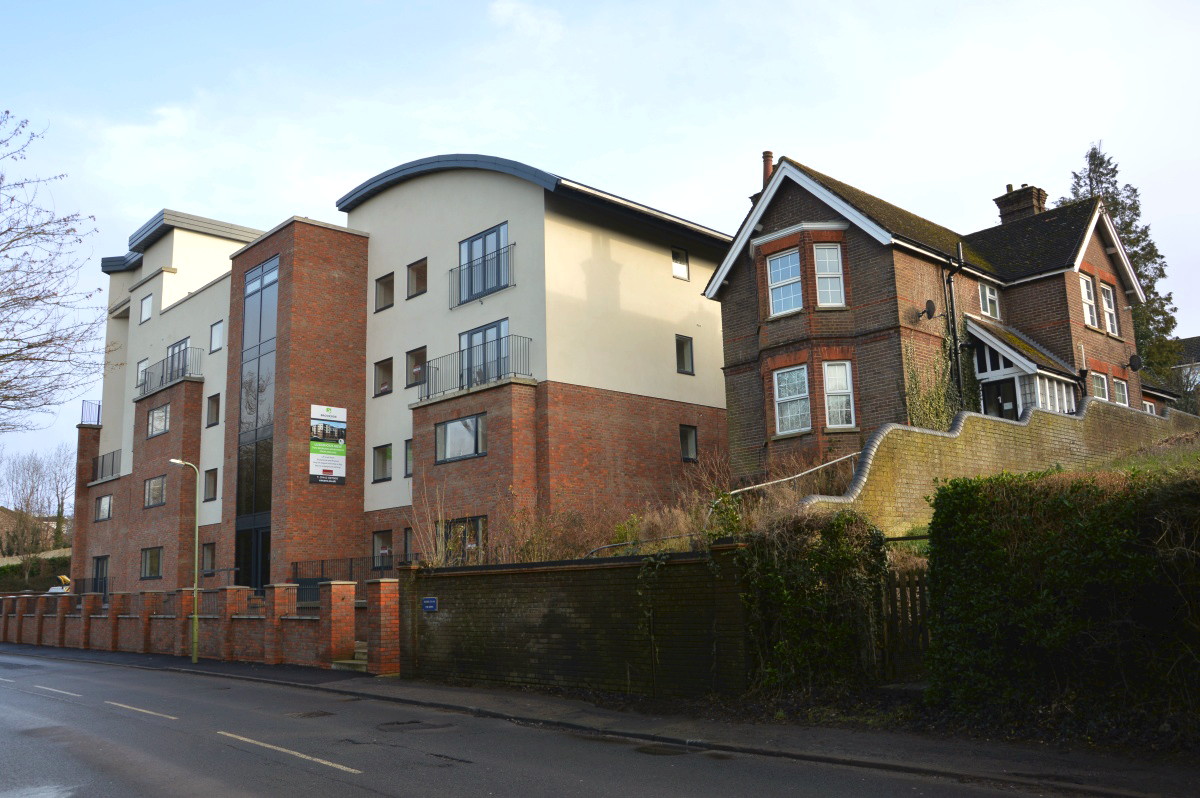
The former gasworks site redeveloped as
'Brookside' - luxury apartments.
The house in the foreground (by Tring architect William Huckvale) was
the Manager’s house.
The longest serving Works Manager was Thomas Thompson, who was appointed
in 1862. In May, 1901, the Board resolved “that in recognition
of the long and valuable services of Mr Thompson the Manager of the
Works & because of his recent serious indisposition, he be given the
opportunity of a rest & change for 3 weeks to be prolonged one more week
if deemed advisable, also a gratuity of £10.” The Minutes
for October 1901 record that “That this Board deeply regrets the
death of Mr. T. Thompson who for upwards of 39 years was a faithful &
capable Manager of the Company’s Works.” The curious thing is
that Thompson’s surname was in fact Roberts, which is the name inscribed
on his gravestone in the New Mill Baptist Cemetery ― how he came to be
addressed as Thompson throughout his long service with the Company is a
mystery. Following Thompson’s death his son took over as Manager.
|
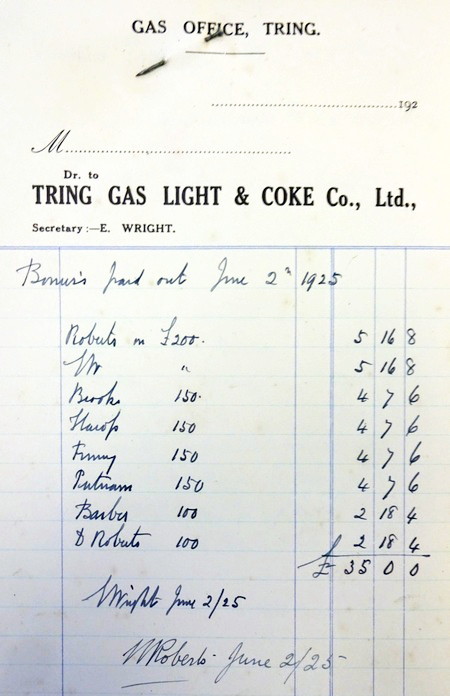 |
|
In the Company’s later years,
its workforce were able to
participate in a profit sharing scheme, paid in proportion
to their wages. |
STOKERS: conditions for the manual
workers employed in early gasworks were harsh, and this was
especially true of the stokers. Their work was to load coal
into, and, following carbonization, unload the manufactured coke out of the
’retorts’
(ovens in which the coal was baked over a furnace to extract the gas ―
see Appendix 1). They also had to tend the
furnaces in hot, dirty and dangerous conditions. The following
describes the stokers’ working conditions at a typical gasworks of the
time:
“There were four stokers, whose main job was to load the retorts
with coal, discharge the coke when carbonisation was complete and
attend to the furnace. It was hot, hard, and dirty work.
The front wall of the retort settings became so hot that the stoker
had to work from several feet back, using long-handled tools.
In order to get the coal evenly spread out, the stoker had to throw
the first shovelful straight to the far end of the retort, a
distance of approximately 5 metres (16 feet) from where he was
standing. When the red hot coke was emptied from the retorts
after carbonisation it burst into flames on contact with the air and
had to be quenched with water, making the atmosphere in the retort
house even more unpleasant and difficult to work in.”
Stokers wore hats to protect their hair from sparks, but it was
too hot to wear many clothes, and of course nobody even thought
about protecting their lungs!
Despite the terrible working conditions in the retort house, some of
the Tring stokers served for many years. The Bucks Herald
mentions two. In July 1937, Mr. & Mrs. T. Brooks celebrated
their golden wedding anniversary, he having served for 49 years with
the Company, and in October 1948 Mr. & Mrs. Fred Harrop celebrated
theirs, he having served for over 30 years, partly as a lamplighter
in the Town.
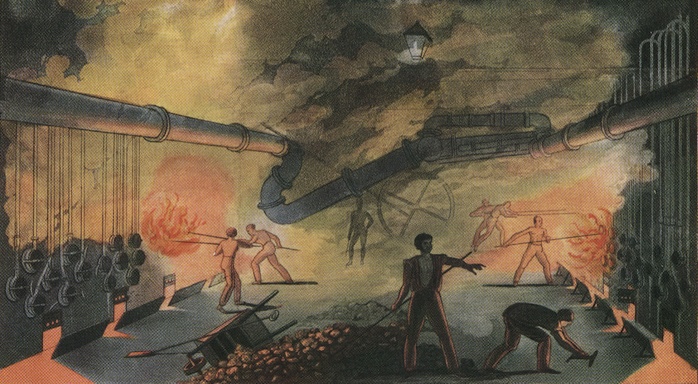
Stokers drawing the retorts in a large
gasworks.
The pay and terms of service of the stokers don’t appear in the
early Minutes and it is not until the 1890s that there is any
indication of what they were. The entry for 8th May, 1894,
records that at that time only one stoker was employed, his wage
being 19s. a week. When the stokers requested a pay rise two
years later “the wages of the two stokers and the lamplighter be
raised 1s. per week for the winter months commencing the 1st week in
October.” Working hours must have been long and
unsociable, for in 1897:
“An application was received from Brooks and Finney, the gas
stokers, that they be permitted each to have one clear Sunday per
month off from the Works. After discussion it was resolved
that their application be acceded to.”
Tring Gas Company Minute Book,
9th March 1897
Despite the rigour of the gas stoker’s lot, Mr. T. Brooks (pictured with
his wife on their 50th wedding anniversary in July 1937) managed to
endure 49 years of service with the Company in that capacity.
However, by 1946 the Company was facing real difficulty recruiting
people prepared to take on this gruelling work:
“SERIOUS POSITION AT
THE TRING GASWORKS.
― The Ministry of Fuel and Power wrote calling attention of the Council
to the continuing serious position existing at the Tring Gasworks, due,
the letter stated, to the complete inability of the gas engineer (who in
the past has been compelled to carry out his own stoking) to obtain
stokers. The Works were badly in need of two, and their absence
endangered the maintenance of gas supplies to the district . . . .”
Bucks Herald, 10th May 1946
When this problem was raised at a meeting of the Tring Urban District
Council, it was agreed that German prisoners of war be put to work in
the retort house and that a letter be sent to the Ministry to that
effect, but the solution that was eventually adopted is unrecorded.
COAL
Coal was the raw material from which Tring’s gas was manufactured and
throughout the life of the Company there are numerous references to it in the
Minutes. These relate to trials to identify the best
gas-yielding coal,
obtaining quotations from coal merchants, signing supply contracts and to the cost of hauling
coal to the Works.
The earliest record of coal being bought was in January 1851, when it is
recorded that “Messrs. Rowbotham and Frederick Butcher reported that
they had agreed with Mr Alfred Penny, Coal Merchant of London, for the
purchase of 49 tons of South Peareth Coals to be delivered to Tring
Wharf at 18s 6d per ton”. Subsequently one Parker was paid £2
10s 3d for haulage to the Works. The names Mead & Bailey appear in the early Minutes ― 8th July 1852, Mead &
Bailey paid 16/4 for “wharfage of coals”; 7th September Evans
paid £1 8s 0d for “carting coals”. Mead & Bailey
were the owners of Gamnel Wharf, so it is reasonable to assume that
early coal deliveries were by canal. However, in 1859 the
Minutes refer to coal being delivered to Tring Station, and there is
no further mention of Gamnel Wharf.
As one would expect, the quantities of coal bought by the Company (and
its price) gradually increased over the years as the town’s population
grew and more people were connected to the supply, which they later used
for cooking and heating. By 1876, the modest initial order of 50
tons at 18s 6d per ton had grown to “500 tons of coal from the Wigan
Coal Company at 19s 5d per ton delivered in Wigan [railway] trucks
to Tring”. In 1885, the Company bought 700 tons of Madeley
screen gas coal at 15s 7d per ton; in 1898, Messrs Hackett & Co contracted
to supply 1,000 tons of coal at 18s 11d per ton; by 1925 the annual order
had risen to 1,600 tons and, by 1929, to 1,800 tons. Although the
Minutes don’t state it, it seems fair to assume that these quantities
equate approximately to the annual coal consumption.
Not all coal was suitable for conversion into gas ― a process referred
to as ’carbonisation’ ― and from time to time the Minutes refer
to trials of different types of coal being made to identify that which
produced the largest quantity of gas per ton. For example, in
April 1925, 4 types of coal were tested, the results being:
|
TYPE |
PRICE PER TON |
YIELD (cu.
ft)/TON |
| Low Staithes |
31s 11d |
12,800 |
| Leashbridge |
32s 03d |
12,450 |
| Barrow |
33s 05d |
12,375 |
| Old Silkstone |
32s 04d |
12,060 |
After further tests the Minutes record that the board decided to
order 1,000 tons of Barrow at 32s 11d, 400 tons of Leashbridge at
32s, and 200 tons Low Staithes at 31s 11d.
|
 |
|
From the Bucks Herald, 16th
March 1921 |
Coal supplies were seriously curtailed on three occasions, which in turn
caused shortages in the amount of gas available to the town. The
first disruption was during the miners’ strike of 1912, the first
national coal strike in Britain. The strike took place at a time
when the distribution of wealth derived from the pits was
disproportionately in the favour of the mine owners. Wages were
set on a sliding scale ― when the coal price went up, wages increased
slightly; when the price of coal decreased, wages plummeted. Thus,
the miners’ goal was to secure a minimum wage. After 37 days of
disruption, and fearing widespread civil unrest, the Government
abandoned its stance of non-intervention and rushed a Bill through
Parliament, from which emerged the Coal Mines (Minimum Wage) Act (1912).
News of the impending strike caused heavy buying that in turn
caused a coal shortage, forcing up prices. At the Company meeting
held on 1st February 1912, the Secretary reported that Messrs. Foster,
the Company’s supplier, had only sent 94 tons of coal since January.
At the following meeting, 150 tons of coal having been received from
Fosters, and in view of the continuing shortage, the Secretary
was instructed to purchase what coal he could. This resulted in some 30
tons being obtained from local coal merchants together with another 10
ton of broken up coal, otherwise known as ’slack’. The directors
also decided not to light the street lamps after 24th March until coal
supplies returned to normal, but this resulted in one of the periodic
spats with the Council Lighting Committee, who insisted that their
contract with the Company had to be honoured and were not not prepared
to have any lamps unlit. The outcome was that only 9 lamps in
various positions in the town were lighted. By April 1912 the coal
position was serious, all that was available was 3 to 4 tons with local
merchants at 32s a ton and a truck at the station at 31s. However,
by June 1912 the position had returned to normal and the Company was
able to obtain 1,000 tons of coal from their supplier.
|
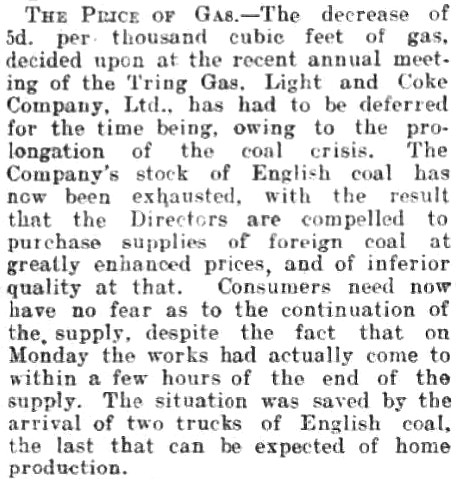 |
|
Bucks Herald, 3rd July 1926 |
A
further strike took place in 1921. During the First World War the
state took control of the coal industry on account of its importance to
industry. Under government control, miners’ wages, hours and
safety improved, and at the end of hostilities the miners wanted to
retain the status quo. Being unwilling to provoke strike
action, Lloyd George’s Coalition-Liberal Government retained control of
the mines until 1921, when the industry was returned to private
ownership and to pre-war working conditions. The ensuing miners’
strike lasted for three months, at the end of which they were forced
back to work on worse terms than they could have had at the start.
A further disruption occurred during the General Strike of 1926, when
the Minutes refer to the serious position obtaining coal and
great difficult maintaining gas supply, but they give no more
detail.
GAS MAINS
The Minutes makes no mention of the original extent of the
Company’s
gas mains, although from the business that later transpired it is
evident that the supply ran up Brook Street to the Robin Hood and then
along the High Street (then called ’Market Street’) to the cross roads
before turning up Akeman Street. Later evidence suggests that the
mains also extended into Frogmore Street. Then, in September 1854,
the directors decided to extend the mains to the “West End” of
the Town. A Special General Meeting of the Shareholders was called
at which this decision was endorsed, subject to the approval of an
engineer (this was the only time that such a formal procedure for
extending the mains was used, later extensions being decided solely at
Board meetings). The plan was that:
“the Company’s Mains be extended from the end
of Market Street to the Bricklayer’s Arms and from the top of Akeman
Street to the Turnpike Road at Miswell Lane.”
Minutes,
24th September 1851
In today’s terms the two extensions were to run (i) along Western Road
to the corner of Duckmore Lane (once the site of the Bricklayer’s Arms)
and (ii) from the top of Akeman Street along Park Road to Chapel Street,
and then down to Western Road. Atkins was invited to give an
opinion on the plan’s feasibility and in due course:
“A Report of Mr Atkins upon the proposed
Extension of the Company’s mains was read by the Secretary, approving of
the said Extension, when it was resolved that the Work be proceeded
with, and that in addition a 2 inch main be laid from the proposed main
by Mr Robert Wright’s along Pleasant Terrace to Mr Garnett Jones’s.
[8]
The Secretary was directed (with the assistance of the Manager at the
Works) to draw up Specifications to be submitted to Mr Atkins and then
to invite Messrs Killy, Mr Atkins, and Mr Chas Grace to tender for the
execution of the proposed Works.
It was resolved that in every case where the Consumers have Gardens
intervening between the Public Road and their Hose the Company do carry
their Services through their Inclosures towards the House to the extent
of 40 feet.
The Secretary was directed to write to the Surveyor to the Turnpike
Trustees for permission to break the Ground in order to lay the
Company’s Mains.”
Minutes,
28th September 1854
The work was to be financed by the issue of 30 new shares of £10 each,
to be offered to existing shareholders in proportion to their holdings.
Three tenders for the project were received. A Mr Crichton having
submitted the lowest bid, at £208 12s., a contract for the work was
signed with him on the 18th October. Work then commenced and
continued into the following month, during which Crichton was paid £150
in three instalments. It appears that the directors took the
prudent step of inserting a retention clause in the contract, for when a
gas leak was discovered in March of the following year, which Crichton
failed to remedy, the Company offset the estimated cost of lost gas
against the balance outstanding on the contract (the question of public
safety is not mentioned).
In September, 1857, the directors considered two possible lengthy mains
extensions.
|
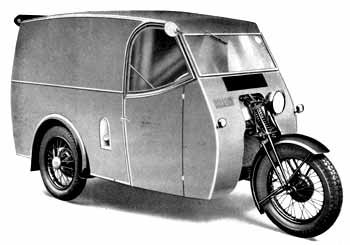 |
|
In adverts for the Raleigh Light
Delivery
Van (c. 1934) the Tring Gas Company is listed
among the vehicle’s ’discriminating users’. |
The first request was from Sir Anthony de Rothschild ― who in the early
1850s had acquired Aston Clinton House ― who asked the Company to quote
for supplying gas to his house and estate. The reply was that the
Company would lay on gas and erect a gas holder for £1,150, and would
supply gas at the same price as for private consumers. Nothing
more came of the proposal, but Sir Anthony later erecting his own
private gasworks on the bank of the Wendover Arm Canal at Aston Clinton
(his relation erected a similar private gasworks on the canal bank
further West to supply Halton House).
The second proposal concerned the railway. When Tring Station was
constructed in 1837, a small gasworks was built at the south end of the
up platform to supply gas for lighting. In September 1857, the
Minutes record that the directors were aware that the London &
North-Western Railway Company was planning to rebuild Tring Station and
that the gasworks was to be taken down. As a result the Secretary
was instructed to write to Captain Huish, the L&NWR Company’s formidable
General Manager, to advise him that the directors were prepared to lay
on gas to the Station, but nothing further is recorded. In later
years the L&NWR asked on several occasions for a quotation to lay on a
gas supply from the Town, but no agreement was reached and the Station
continued to generate its own gas from a small gasworks, by then located
on the North-East side of the Station Road bridge.
Nothing further is recorded on extending the mains until November 1875,
when a considerable extension was made, although its impact appears to
have been limited to supplying gas to the residences of just two of the
Town’s better off citizens:
“A detailed statement of the cost of laying the
new Main from Brook Street to Mr. Wm. Brown’s residence [and]
from thence to the entrance of Mr Williams’ Park in the Station Road, a
distance of 1765 yards, was laid before the Meeting. The total
cost of same amounted to the sum of three hundred and forty nine pounds.
Also the Moiety of the cost of laying the new three inch main from Beech
Grove to the entrance of Pendley Park, a distance of one thousand and
seventy five yards amounting to the sum of one hundred and four pounds
nineteen shillings and seven pence was examined and approved.”
Minutes, 11th November 1875
Nothing further is recorded in the Minutes, but later business
shows that the work was completed.
In 1886, the mains were extended along Brook Street to New Mill Baptist
Chapel (dealt with in the next section) and to Tring Wharf. In the
previous year an enquiry had been made to the Company (under the Tring
Drainage Scheme) to know what their terms would be to extend the mains
to the new sewage works for lighting and to power a 1 h.p. gas pumping
engine. The Company estimated the cost at £300 and offered to do
the work if the Tring Local Board would either pay half the cost, or
guarantee gas consumption at the Works of at least £50 p.a. for 7 years.
Nothing further is recorded in the Minutes, but it is possible
that the extension to Tring Wharf, carried out in the following year,
also satisfied the new sewage works’ requirement. Then, in 1890:
“Mr Carr, Lord Rothschild’s agent, having
requested the Directors to state the terms upon which they would lay in
a new gas main to supply the new laundry house offices, now in course of
erection, was informed that this Company would lay in a main from the
present main in Frogmore Street to a point opposite the entrance to the
new laundry, using 2½ inch and 2 inch pipes now in stock at the Works on
condition that Lord Rothschild pay the Company £25 towards the cost
thereof. Mr Carr on behalf of Lord Rothschild having accepted
those terms the Secretary was directed to proceed with the work
forthwith.”
Minutes, 15th July 1890
The Rothschild laundry was on the right at the crest of Dundale Hill
where St Peters Place now is. Although a public electricity supply
to the Town lay some years in the future, Lord Rothschild installed a
private electricity generator at the Silk Mill to provide lighting for
the Mansion, the new laundry and other Rothschild concerns.
Further extensions took place during 1891:
“A new 6 inch main be put in from the GEORGE corner to a point
opposite Chapel Street and thence continued with a new 4 inch main to
the end . . . . The Secretary was instructed, after consulting Thompson,
[the Gasworks Manager] to ask Mr
Grace to give him an estimate for supplying and laying in the proposed
new Main, also an estimate for carrying out the Works, the Company
supplying the pipes, etc.”
Minutes, 10th March 1891
“Mr Grace’s tender for supplying all material, carting and laying in
the new main along Western Road, according to specification, for the sum
of £235 15s 0d was accepted, the work to begin early in June and
completed 5 weeks from the time of commencement. The Secretary to
write to the Chairman of the Local Board asking permission to open the
ground as required.”
Minutes, 19th March 1891
“As agent for and on behalf of J. G. Williams Esq., I
[Septimus
G Foulks] hereby sanction a Gas main to be put
under the new Road (Christ Church Road) extending from Parsonage Bottom
to the entrance of Mr Frank Brown’s new residence, such main being the
property of the Tring Gas Co. and they be allowed free access to the
same at any time.”
Minutes, 14th July 1891
|
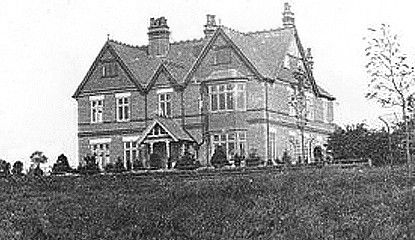 |
|
Okeford |
Frank
Brown was then the principal partner of William Brown & Co., auctioneers
and land surveyors, later to become Brown & Merry. ’Parsonage
Bottom’ was the name for the dip in Christchurch Road, then the location
of a farm. “Mr Brown’s new residence” refers to ’Okeford’,
the splendid house that he built at the top of Christchurch Road, now
the site of Okeford Drive ― the house name was taken from Okeford
Fitzpaine in Dorset, from where John and William Brown originated.
In its latter days the building served as Osmington School
before being pulled down to make way for residential housing.
In following years, as the town grew, the gas mains were extended
further, but as extensions became common less details are recorded in
the Minutes.
WATCHING AND LIGHTING
The reasons for erecting a gasworks in the Town were to provide
improved street and domestic lighting ― other uses of gas lay well in
the future. To estimate how much gas would be needed for
these purposes, the directors undertook a survey of potential
customers:
“We have received promises of 150 private lights; in addition to
these, the probable consumption of Gas in the places of Public Worship,
the Silk Mill and in the public Streets will be equal at least to 60
more.”
Tring Gas Company Minute Book,
19th April 1850
The Lighting and Watching Act of 1833 was the first statute to deal with the establishment of paid
police forces in England and Wales. It enabled, but didn’t
require, boroughs to form police forces along the lines of London’s
Metropolitan Police, which had been set up in 1829. The Act
allowed groups of property owners to form committees to organise local
police forces (the ’watching’ part of the Act) and street lighting
(mainly to combat street crime) and
they were empowered to levy a rate on householders to pay for these
services. In fact Tring had recruited two watchmen some years
previously:
July 1826:
“A vestry was held ’for the purpose of considering the
propriety of establishing Watchmen in the town’, and the Guardians of
the Poor were requested to look out two of the paupers for this duty.
There were two watchmen who walked round at night, but did not call the
hours.”
From Arthur MacDonald Brown’s notes
The policing provisions of the Act appear to have been implemented in Tring
by
1836, for an article in the Bucks Herald of November that year
refers to
“H. J. Coulter, one of the Tring police” making an arrest on
suspicion of the theft of fowl; Arthur MacDonald records in his notes that “Coulter and Johnson
were the first two policemen here ― they came shortly before the railway
opened” [1837], by which time the Town had acquired street lighting:
“A public meeting of the ratepayers was held to determine whether the
Act for Lighting and Watching Parishes shall be adopted in Tring.
It was carried unanimously and the Provisions of the Act should be
carried out in the Town and the suburbs, and that there be 7 Inspectors
for the purpose, also that £105 be raised for the purpose. It was
resolved that the boundaries of the Town and suburbs be considered to
extend to Miss Miles’ house in London Road, Mr. John Mead’s house in the
Wingrave Road, Mr. W. Griffin’s house in the Aylesbury Road, the house
of the Revd. Jeffery, Aylesbury Lane, Tring Park and premises, and
Maidenhead Street.”
From the Tring Vestry Minutes for 1836
Tring’s original street lamps are believed to have been Naphtha flare
lamps, the forerunners of the nowadays widely known high pressure
paraffin ’tilley’ lamps. Invented around 1830, they were also
widely used by showmen, market-stall holders and circuses until World
War I:
“1844: Situation of lamps to be fixed ― pillar lamp in open space
near Robin Hood; Bracket lamps at Green Man; Ivy House. Wright’s; by
Bull’s Ally (Bank Ally); on James Wilson’s cottage. Mrs Mary
Tomkins & Son ordered to procure lamps and about 30 gallons of Naphtha.
Order to Overseers to raise £44 by rate upon occupiers of property
adjoining the road from Mile Post at Dunsley to Mr. John Mead’s house at
the entrance of the Town from Aylesbury.
Oct. 1845: Lamps not lighted since April 7th. Mrs Northwood’s lamp over
Rose & crown half expense of lighting to be borne by Inspectors.
Nov. 1846: Pillar lamp to be placed at Cross roads near Post Office
(Bedford’s shop) in such position as may hereafter be determined.
Meetings held in Commercial Hall.”
From Arthur MacDonald Brown’s notes
The Gas Company Minutes don’t record how many gas street lights were
erected, but by October 1850 their contractor, Atkins, reported to the
Board that the new gas lamps were nearly ready for use. The Board
therefore decided to approach the Town’s Lighting Inspectors with a
proposition:
“That the year shall end on the Second week in April 1851 if so long
required by the Inspectors, and that the lamps shall be lighted entirely
at the Expense of the Company at 42s per lamp and that the lamps be not
lighted at the full of the Moon five nights on average.”
Tring
Gas Company Minute Book, 2nd October 1850
On its
formation in 1850, the duties of the Lighting Inspectors were taken over by the Tring Local Board of Health. [9]
Although the Gas Company Minutes continue to refer to the
“Lighting Inspectors”, a Lighting Committee of the Local Board took
over the management of street lighting, and, until gas lighting was
replaced by electricity in 1928, there
were to be exchanges of correspondence (and sometimes of views!) between them and the Gas Company over
the price of gas lighting and the cost of maintaining the town’s street lamps.
Eventually, in 1861, the Company agreed a contract with the Local Board
to take charge of the town’s (then) 40 street lamps, keep them painted and
repaired, light them on 140 nights from 1st June for an average of 6
hours a night at a cost of £2 10s. 0d per lamp. But the agreement
didn’t always run smoothly and there are a number of entries in the
Company’s Minutes that record spats between the Local Board and the
Company over lamplight maintenance. For instance, in May 1899, the Local
Board Secretary wrote to the Company complaining that insufficient
allowance has been made in their half-yearly charges for “partial
lighting” (i.e. nights on which the moon was sufficiently bright to
allow the lamps to be lit for shorter periods). In their reply the
Company disagreed, pointing out that the existing agreement had been
made when there were 51 public lamps in operation, a number that had
gradually increased to 72 without any corresponding increase in the
amount charged for lighting them. This retort silenced the
Lighting Committee, for nothing further is recorded on the matter; they
should have kept quiet, for in the following year the Company increased
their charges to take account of the increased number of street lamps,
by then 75.
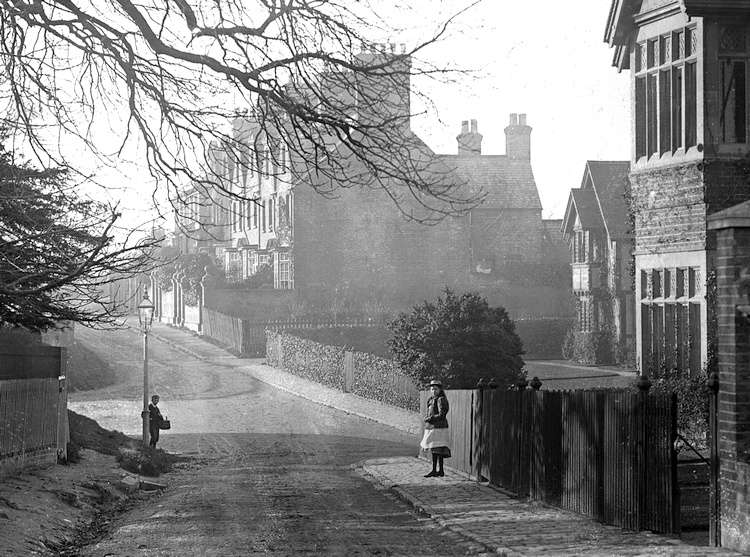
Gas street lamp at the junction of Akeman
Street and Park Street, Tring (courtesy Mike Bass)
For
the remainder of the life of Tring’s gas street lights, a supply and
maintenance contract ― updated from time-to-time ― between the Gas
Company and the Local Board (from 1894, the Tring Urban District
Council) remained in force. By 1922, shortly before electricity
took over from gas as the lighting agent, Tring had 80 street lamps in
operation for which the Company quoted £4 3s per lamp for gas and
maintenance.
In addition to correspondence on the operational costs of street lighting, an occasional request was received from the Council
to extend the gas mains so that additional street lights could be
provided. The following is a case in point:
Tring 9th Novr. 1885
Dear Sir
I am directed by the Board to send you for the consideration of your
Company the enclosed memorials as to the public lighting of the road
between the gas works and New Mill with a recommendation to your Company
to consider the matter formally.
I may say that the Board would be willing to erect the necessary public
lights on your Company laying the mains.
Yours Faithfully,
A. W. Vaisey
Subsequently the Council Lighting Committee offered the Gas Company 10
shillings extra per lamp per annum to supply and maintain the new lamps
for a period of five years in consideration of the Company paying for
the whole work of laying the new main.
Tring Gas Company, Feb 1st 1886
Gentlemen.
In reply to your letter of the 11th Jany. last I am directed to inform
you that the Directors of the Gas Company fear that the offer of the
Local Board will entail upon them a heavier loss than they ought to bear
and they regret a more equitable offer has not been made. But
considering that the new lamps will be a great public benefit they have
resolved to accept it and they will lay a four inch main from the Gas
Works to Tring Wharf in accordance with the wishes of the Local Board.
I am
Yours Truly
J. Amsden, Secretary
News of the project to lay the new main soon reached the ears of the New
Mill Chapel elders, but rather than approach the Gas Company they
decided to enlist the support Frederick Butcher, a leading citizen of
the town and an ardent Baptist:
15 Akeman St Tring
31st March 1886
Fredk. Butcher Esq
Chairman of Tring Local Board
Dear Sir.
On behalf of the New Mill Baptist Church I am requested to inform you
that we learn with much pleasure the decision of the Board to light the
road from the gasworks to the Tring Wharf. We earnestly hope that
you may see your way to laying a main along the new road to the Chapel
as we are anxious to light it with gas.
I am
Yours very Respectfully
Thomas Grace
Secretary
. . . . who in turn sent it forward to the Gas Company:
Tring Gas Company, April 21st 1886
Dear Sir
Your letter of the 5th Inst. containing a copy of Mr. T. Grace’s letter
to the Chairman of the Tring Local Board was duly laid before my
Directors at a meeting here last evening. And it was unanimously
resolved to comply with the request contained therein and lay a main to
New Mill Chapel.
I Am
Yours Truly
J. Amsden.
Whether the Gas Company saw any profit in so doing is not recorded, but
gaslight came to New Mill Chapel in 1886.
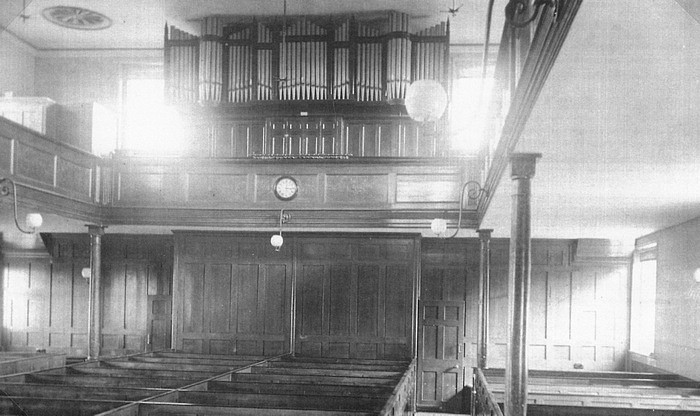
The interior of New Mill Chapel in the 1920s
showing the gaslights in place
|
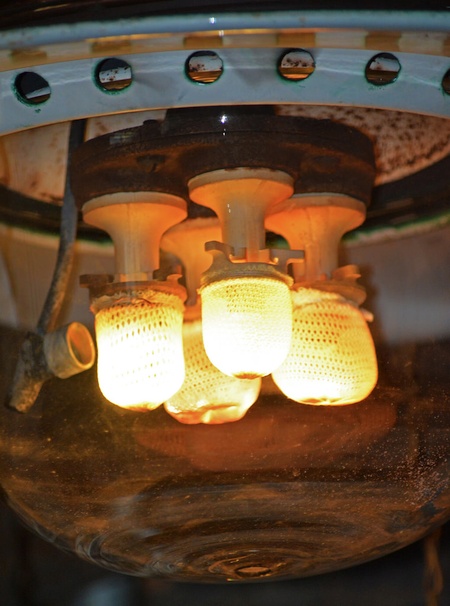 |
|
Gas mantles |
In 1887
an important improvement was made to gas lighting with the invention of
the ’incandescent mantle’. Gas mantles are fabric items
impregnation with metal nitrates. When heated by a flame, a mantle
forms a rigid but fragile mesh of metal oxides that produces a very
bright light, much brighter than the naked gas flame that preceded it.
The gas mantle was to form an important component of street lighting
until replaced by electric lamps. Today, mantles are still used in
portable camping lanterns, pressure lanterns and some oil lamps.
GAS FOR COOKING AND HEATING.
In his unpublished notes, the late Tring local historian Ron Kitchener
commented “Many folk were frightened of ’the
new-fangled things’ and stuck to coal and wood fires, candles and
paraffin lamps even as recent as the 1960s.”
The initial purpose of a gasworks was to provide gas for lighting,
principally for street lighting but from the mid-19th century gas was
used increasingly for domestic lighting. As people had a coal fire
for heating, they generally had a coal fired ’kitchen range’ for
cooking. Although rudimentary gas
cookers had been invented during the 1820s, they were little used.
It was not until gas cookers were shown at the World Fair in London in
1851 that they began to gain acceptance, although their use at this time was
restricted mainly to more wealthy households.
By the 1880s it had become apparent that electricity would eventually
replace gas as a source of lighting and, having looked
around for other potential revenue-earning uses for their product,
gas companies began
to promote gas for cooking and heating. This coincided with the
appearance of the pre-payment (or slot) gas meter, which, together
with gas companies beginning to offer their customers gas cookers to rent,
were important steps in making gas more affordable to the wider community.
The invention of the oven thermostat in 1923 was a further
development in popularising the gas cooker.
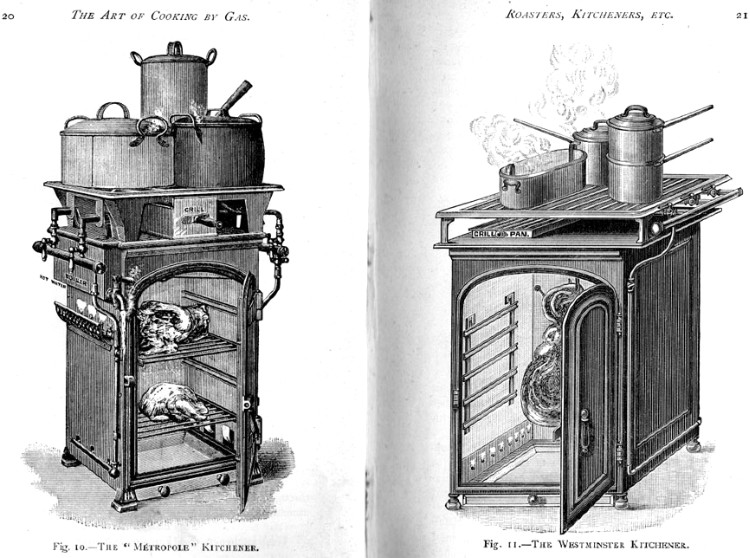
Early gas stoves by Sugg
As for gas heating, by the mid 19th century gas fires had been designed, usually
incorporating tufted asbestos heated by gas burners, but coal remained
the preferred fuel until well into the 20th century. Ceramic
radiant fires were introduced in 1905 and the efficiency of gas fires
was improved substantially in the 1950s with the development of
convector fires, which use a heat exchanger to recover heat from the
flue gasses. The big change to heating followed the Clean Air Act (1956),
which restricted the use of solid
fuel in urban areas and led to a massive increase in the popularity of
gas fires, space heaters and central heating boilers.
At Tring, the earliest reference to prepayment meters and rented cookers
in the gas company’s Minutes was in 1896, when . . . .
“The Secretary was instructed to order one
each of Nos 8, 9 & 10 Davis’s gas cookers and also 4 prepayment meters. Mr [Jesse] Hansford of the Grammar
School Western Road, having asked if the Company would lay on the gas to
the house occupied by him and provide a gas cooker there and on
what terms, the Secretary was instructed to inform him that the Company
would be willing to do so without charge on condition that he be
supplied with gas through a prepayment meter.”
Minutes,
14th July 1896
It appears that this innovation soon became popular, for by 1903 the load on the workforce had increased:
“Thompson the manager at the Works attended
the meeting and stated that, in consequence of the Introduction into the
Town of gas cookers and automatic gas meters, the labour in the retort
house and yards is increased, while at the same time the fixing of the
cookers, automatic meters and their service pipes had for some weeks
past taken up the whole time of Thompson’s son. Consequently an
extra man had been employed. The stokers also asked for an
increase in their wages. It was resolved that the extra man be
kept on and that the wages of the 2 stokers and the lamplighter by
raised 1/- per week for the winter months commencing the 1st week in
October.”
Minutes, 10th Nov 1903
“Company to reduce rent for gas stoves to 1/- per quarter for those
whose house rent does not exceed 5/- per week. This proved difficult to
implement, so all prepayment meter customers charged 1/- per quarter.”
Minutes, 27th May 1907
Of course a perennial problem with prepayment meters was theft of the
takings:
“The
Secretary informed the Directors that a prepayment meter in Mr Green’s
cycle shop had been broken open and the money, amounting to about 16/-
taken out. Mr Green declined to refund the amount. After
considerable discussion, it was decided not to take any further steps at
present in the hope that some precedent of a similar case may be found,
and the box of this meter be cleared weekly, which has been done since
the occurrence.”
Minutes, 10th Nov 1903
But on the other side of that particular coin, prepayment was a means of
curbing the amount of late payments and bad debts:
“The
Secretary informed the Directors that Mr John Green of Akeman Street
owed for 5 quarters gas. He was instructed to press for payment
and have a prepayment meter put in.”
Minutes, 12th Jan 1904
|
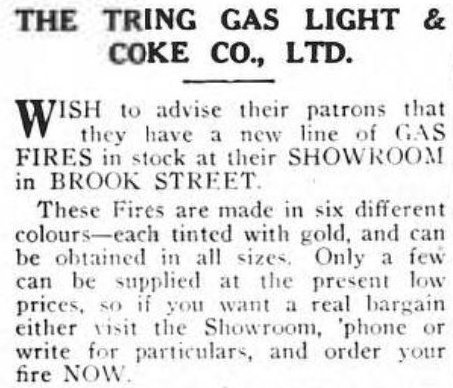 |
|
Bucks Herald, 6th October 1933 |
In later
years the Company appears to have made a more determined effort to sell/rent
gas appliances, probably encouraged by the decline in the use of gas for both street
and domestic lighting following the arrival of mains electricity in the
town in 1926:
“The Tring
Gas, Light and Coke Co., Ltd., begs to inform its Patrons that a SHOW
ROOM has been opened at their Office and Works in Brook-street, where a
stock of modern Cookers, Fires, Boilers and lamps, etc., may be seen.
An inspection of same is cordially invited.”
Bucks Herald, 5th February 1932.
In addition to promoting their new showroom, the Company also arranged
demonstrations in the art of gas cooking:
“COOKERY DEMONSTRATION.
― There have been large attendances at the Church House during the week
to witness cookery demonstrations arranged by the Tring Gas, Light and
Coke Company, in conjunction with Messrs. Richmond and Company, and the
manufacturers of Radiation appliances. The exhibition was opened by Mr.
John Bly, Chairman of the Urban District Council, who was introduced by
Mr Ed. Wright, Secretary and Director of the Gas Company. Cookery
demonstrations on the latest type of gas stove were given by Miss D.
Jaques, and a cake-making competition will be judged today (Friday).
Many modern gas appliances were on view, including stoves, fires,
geysers and modern lighting.”
Bucks Herald,
27th May 1932
“GAS
EXHIBITION. ― The gas exhibition and cookery demonstrations recently
held at the Church House by the Tring Gas, Light and Coke Co., Ltd.,
proved to be very successful. The exhibition extended over four
days, and there were two cookery demonstrations daily, given by Miss Jaques, of Radiation, Ltd. There was good attendance on the first
afternoon, when My John Bly declared the exhibition open, but the
numbers so increased at every demonstration that on the last night many
had to be turned away owing to the hall being full. The cake
competition was very keenly contested. There were 36 entries.”
Bucks Herald,
10th June 1932
The Company’s efforts to promote the use of gas for cooking and heating
against the declining use of gas for lighting appears to have borne fruit, for
at their 83rd annual general meeting held in April 1934, the Chairman
was able to report increased gas sales of 16,211,200 cu. ft against
15,144,100 cu. ft. in the previous year. The Minutes make
little reference to the Company’s accounts, but from what information
there it is apparent that revenue from appliance rental contracts
increased in each of the 5 years (incl.) from 1936 (£229 16s 5d) to 1940
(£363 5s 5d).
TRING GASWORKS’ FINAL YEARS
In 1930 the Tring Gas Light & Coke Company was bought, first by Mr W. S.
Coles of Watford and then ― it is unclear exactly when, but probably in
1935 ― by the General Gas and Electricity Company. Following an
Act of Parliament in 1936, the Tring Gas Light & Coke Company was
dissolved and re-incorporated as the Tring Gas Company, with further
powers to improve the gasworks and raise additional capital.
Further change took place in 1945 when the Company was again taken over,
this time by the United Kingdom Gas Corporation, a holding company that
controlled numerous local gas utilities including, in this area, those
at Aylesbury, Thame, Winslow and Woburn.
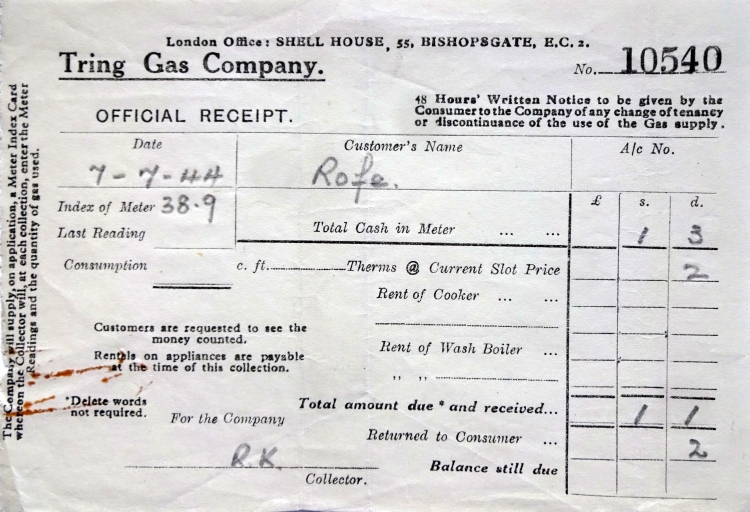
In 1945 Churchill’s coalition government fell and the Labour Party came to power under Clement Atlee.
The new government
soon commenced a massive programme of nationalisation. In 1948,
the Gas Act nationalised the UK
gas industry by bringing into state ownership 1,062 privately owned and
municipal gas companies. These were merged into twelve area gas
boards, each with their own management structure. These area boards became known to their
customers as the
’Gas
Board’,
a term that is still sometimes applied to British Gas. From 1st May 1949,
the Tring Gas Company was incorporated into the Southern Gas Board.
Nationalisation brought with it the construction of a gas supply grid
and more efficient larger centres of gas production. Following the completion of a gas main
from Oxford to Aylesbury, gas making at Aylesbury ceased and Aylesbury gasworks was demolished
in 1956-57. Coal gas continued to be produced at Tring
until, in 1957, the Bucks Herald informed its readers that:
“Tring
gas now comes from Oxford. For 105
[107]
years the 5,000 people of Tring
have had a gasworks, but Southern Gas now pipe from Oxford”.
[10]
Bucks Herald 19th April
1957
. . . . that was until St Ebbe’s gasworks at Oxford closed in 1960;
thereafter, until North Sea gas became available in 1971, Oxford’s
consumers received their gas from Southampton and Reading.
Coal gas was soon to fall out of general use. [11] Surveys had shown
that large reserves of natural gas lay under the North Sea and in 1966 the
decision was taken to convert the UK from coal gas to natural gas.
In the following year the first natural gas from the North Sea arrived
and over the next 10 years British Gas carried out a massive programme
to convert gas appliances to burn this new type of fuel. Tring
switched to natural gas at the beginning of 1969 . . . .
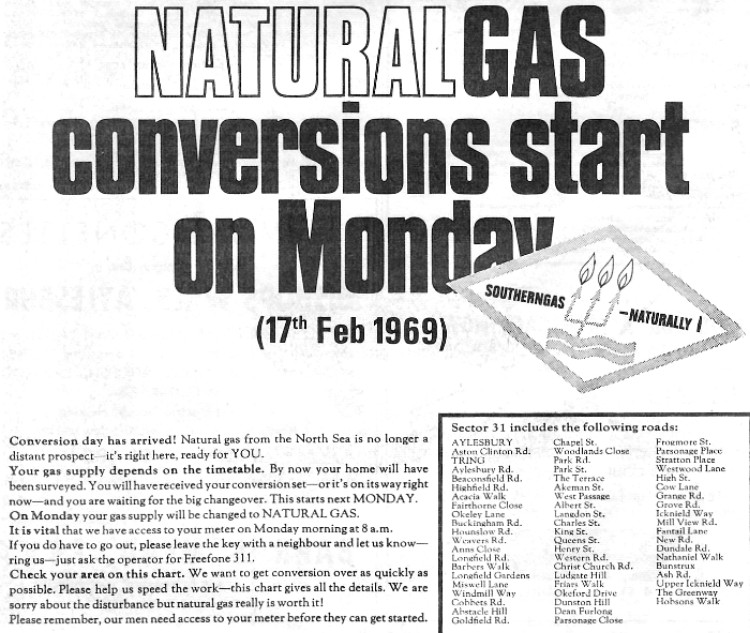
MAINS ELECTRICITY ― HISTORICAL NOTE
The invention of the incandescent light bulb (around 1880, by Swan in
Britain and Edison in the USA) made electric power more attractive than
gas for indoor lighting ― it was safer, cleaner and didn’t smell.
In 1881 the world’s first electric street lighting was installed in
Goldalming in Surrey; being water-driven, the town’s power station also
became the Britain’s first hydroelectric plant.
Most early electricity generating stations used steam reciprocating
(i.e. pistons driving a crankshaft) engines to generate direct current
(DC), which was stored in lead acid accumulators to provide power when
the generators weren’t running. Some of the early generating systems
described below are of this type.
Invented in 1884, the steam turbine proved to be a more effective power
source than steam reciprocating engines for producing the high shaft
speeds required for generating alternating current (AC), and steam
turbine alternators remain the main power generators to this day.
The great advantage of AC over DC is that it is possible with AC (but
not DC) to use transformers to increase or decrease the voltage, thus
allowing electricity to be transmitted over much greater distances using
very high voltages and low current flows (the amount
of power lost in transmission increases with current).
However, it wasn’t until our high-voltage electric power
transmission network, the ’National Grid’,
began operating in September 1933
that
(50 Hz)
AC became the UK standard.
TRING’S FIRST ELECTRICITY USERS
Although a public electricity supply did not become available in Tring until
1926, electricity for domestic lighting had been used by some of the
town’s most affluent citizens from the early 1890s.
Lord Rothschild of Tring Park appears to have been the first:
“TRING
― Mr. C. Burman Callow, who left Tring in July last, after four years’
residence, during which time he laid down the present extensive and
complicated plant and installation for the generation of electric light
and power at Lord Rothschild’s residence, Tring Park, rejoined his old
firm of Messrs. Laing, Wharton, and Down, of New Bond Street, London.
He has since been engaged in carrying out their contract for laying down
an installation for supplying upwards of 1,300 electric lights in the
Brompton Hospital for Consumption . . . .”
Bucks Herald, 28th December 1895
The Bucks Herald reported that electricity was used in 1893 to
light the Tring Park gate posts, although it was probably available
earlier:
“New
lampposts for Tring Park Gates ― a pair of very beautiful and elaborate
wrought-iron posts, to be fitted with powerful electric lights, are in
course of erection at the new town gates of Tring Park. They are
manufactured by Messrs. Dettilde and Co., of Archer-street,
Shaftesbury-avenue, from designs made specially, and will add materially
to the handsome wrought-iron gates lately erected by Messrs. Brown, of
Birmingham.”
Bucks Herald, 11th March 1893
Where the electric plant in Tring Park was located is unknown,
although the following article suggests it was powered by a steam engine
that needed cooling water to condense its exhaust
steam:
“Rapid growth of fish in warm water ― in the month of February last a
number of gold and silver fish were turned into the large Condensing
Pond at the rear of the Electric Light Works at Tring Park, the water of
which is always warm, the temperature varying from 65 or 70 degrees to
100, [Fahrenheit] according to the working of the engines.
The tendency of this warm water has been to greatly accelerate the
growth and development of the fish . . . . The pond, which is
round in shape, between 50 and 60 feet in circumference, and 3 feet
deep, also contains some fine specimens of Prussian carp and tench, the
former weighing over 8lbs each.”
Bucks Herald, 4th November
1893
By the final decade of the 19th century the business at Tring’s Silk
Mill, which had been running at a loss for a good many years, ceased to
be viable and it was finally closed in 1897. This rendered the Mill’s
large engine room redundant, resulting in plans being made to use it to
replace the existing electricity generating station in Tring Park.
The new, sizeable, power plant was installed by Walter Thomas, a
former marine engineer, whose daughter left a memoir of her father’s
work:
“In 1895 . . . . he learned that the Rothschilds of Tring Park in
Hertfordshire were seeking an engineer to convert a large disused silk
mill in Brook Street into a power station capable of electrifying the
whole estate, a challenge to any engineer, but one he accepted gladly.
His first task was to remove two storeys from the mill, while cables had
to be laid to the Mansion, Home Farm, the Stud Farm at West Leith the
Pedigree Herd Farm at Hastoe and, later, the Museum. The power
station when completed was an engineer’s dream and your grandfather,
with carte blanche to purchase the best, was a welcome visitor to the
engineering firms of the City! The floor consisted of black and
white marble slabs, the walls of glazed tiles, the great switchboard was
of polished slate, and the instruments from Negretti & Zambra. A
vast storage room of cells and records office completed the ground
floor, while down below ground level were the boiler room and the
gigantic [water] wheel which had run the looms of the silk mill.”
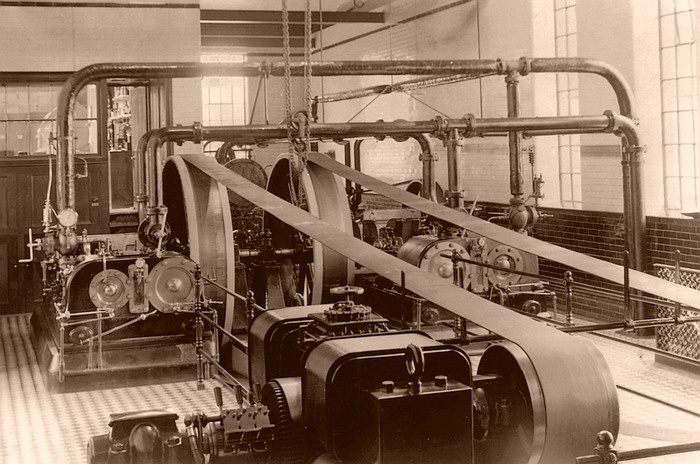
The Silk Mill Power Station,
Brook Street, Tring.
Above: the steam reciprocating engines with
belt drive to the dynamos.
Below: the dynamos (DC) and switchboard.
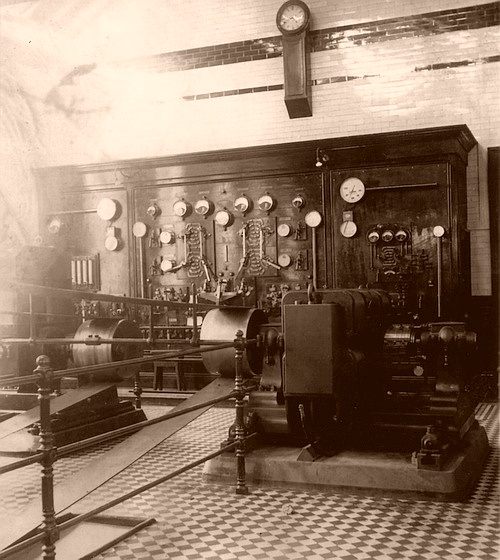
Pictures courtesy Linda McGhee
Another early user of electricity in Tring was the Parish Church.
The generating plant ― installed in the gatehouse leading to
the Vicarage ― comprised a 4½ h.p gas engine running on coal gas
from the mains. The engine drove a dynamo, which charged a bank of
lead acid accumulators, which, once charged, could run the Church
lighting system for up to 5 hours. Electric lighting was made
possible . . . .
“. . . . owing to the advent of the metallic filament lamp,
which requires 70 per cent less energy for a given candle power compared
with the original carbon filament lamp, electricity for Church lighting
is now well within the bounds of possibility . . . .”
Bucks Herald, 8th May 1909
MAINS ELECTRICITY COMES TO TRING
It is now necessary to look at developments in Aylesbury, for it was
from there that Tring obtained its first mains electricity. (Appendix
3)
The public supply of electricity in Aylesbury commenced in May 1915.
The first power station used two 100 KW oil engine generating sets
producing
current at 110 volts
DC, across which floated a 600-ampere-hour accumulator. The
Bucks Herald described the opening of the new power station:
“The visitors entered the battery room, where Mr Turnbull
[resident engineer] explained that the accumulators, which consisted
of 250 cells of 600 ampere hour capacity ― equivalent to a supply of
about 30 horse power for ten hours ― were used for the storage of
electricity. They did not want to keep the engines on for 24 hours
for a few loads, and so they could take the electricity they wanted in
many instances from those batteries.
Proceeding to the engine room where are situated the two 150 horse-power
engines and dynamos, Mr Turnbull explained that these were run on fuel
oil which abounds in the earth in large quantities in many parts of the
world. An explanation of the switchboard followed, it being
pointed out that this controlled and measured the quantities of
electricity produced by the dynamos, and distributed it to different
parts of the town. Mr Turnbull displayed the special feeders for
Walton-street, the Market-square, Buckingham-street, and a special power
feeder out to the Tring-road district.
The Chairman then gave instructions for an engine to be started and
electricity to be put on to the switchboard. This having been
done, Councillor Adkins switched on the supply to the west side of the
High-street and to Messrs. Richards’ timber-yard, the latter
having kindly allowed the Council to connect with his up-to-date
machinery in order to give the visitors a good idea of the great
advantages of the current. Examples of the application of
electricity were witnessed in the centrifugal pump drawing water from
the canal for cooling the engines, the electric show board, and an
instance of electric cooking . . . . in the engineer’s office,
where further examples of the application of electricity were given in
heating, ozone, drilling, ironing, and lighting.”
Bucks Herald, 29th May 1915
A large
number of consumers were connected to the new system, but as the War
progressed the manufacture of munitions increased the higher demand for electric
power. By the end of 1916 the
battery capacity had been enlarged by an additional 50 per cent, but by
then the demand from the munitions factories had increased to the extent
that it also became necessary to enlarge the generating plant. New
plant entering operation in January 1918, but this too was soon found insufficient.
In August 1920, a 1,000 KW steam-driven installation was commissioned.
The new generating station was situated near the town centre by the side
of the canal, which supplied the necessary cooling water and enabled the
convenient handling of fuel from barges. By now DC had been
abandoned in favour of AC, the new steam
turbo-alternator generating a 3-phase supply at 6,600 volts.
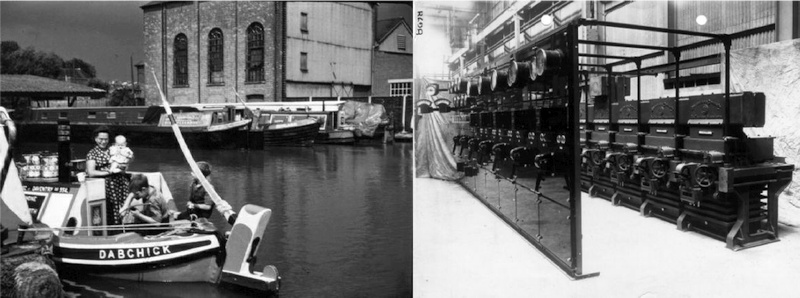
Aylesbury Power Station: building and
switchboard (dates unkown).
In 1924, the Borough of Aylesbury applied to the Electricity
Commissioners (a Government department set up to regulate the
electricity supply industry in its early days) for authority under the
Electricity Supply Acts to extend their supply of electricity beyond
Aylesbury to outlying areas, among which were Tring, Puttenham, Aldbury
and Wigginton ― or, as the quaint wording of the application put
it:
“To authorise the Corporation to open, break up, and interfere with
all streets, roads and public places, ways, footpaths, bridges,
culverts, sewers, drains, and gas and water mains and pipes and
telegraph and telephone and other wires within the area of supply, and
to lay down, erect, maintain, renew and remove either above or
underground or otherwise electric lines, conductors, mains pipes, tubes,
wires, posts, street or distributing boxes, meters, apparatus or other
works or things required for the purpose of enabling the Company to
generate, supply, store, convey, transmit or distribute electricity
within added areas, and to confer all such other powers upon the
Corporation as may be necessary for effecting the objects of the
proposed undertaking.”
Bucks Herald, 13th December 1924
. . . . and that, in legal terms, was a watertight case
for extending the mains expressed in a single sentence! The notice
goes on to say that in Tring, the mains were to run along Western Road
from its junction with Duckmore Lane, through the High Street passing
the junction with Brook Street and extending along Station Road as far
as Hawkwell.
And so mains electricity arrived in Tring:
“Aylesbury Corporation’s scheme of extending electrical supply to the
rural areas took definite form on Monday, and Tring has the distinction
of being the first place to receive the current. The principal shops in
High-street are being supplied with electricity and many householders
are availing themselves of the advantages electricity offers. Up
to the present there are about 70 installations in Tring.
That Monday was an epoch-making day in the history of the town will be
realised more as time goes on, and the use of electricity develops.
The main line runs by Bunstrux Hill, and from there a branch line about
half-a-mile in length runs to Tring. The main line continues to
Northfield, and there are also branch lines to Aldbury, Wigginton, and
the Grand Junction Canal Pumping Station at Little Tring. The
Tring supply is controlled from a kiosk by the George Hotel, and here
the Vice-Chairman of the Council (Mr. J. Bly) . . . . performed the
simple ceremony of ’switching on’, which marks the advent of a new era
for Tring.”
Bucks Herald, 25th December 1926
The first in the area to benefit from electric power on an
industrial scale were the Chiltern Hills Spring Water Company at their
pumping station at Dancers End, and the Grand Junction Canal Company at their pumping
station at Little Tring. Until the arrival of mains electricity,
both companies relied on elderly steam beam engines to drive their
pumps:
. . . .the Chiltern Hills Spring Water Company’s pumping
station at Dancers End was reached. Here again the use of electricity
for industrial purposes was shown. Old steam pumps, still to be seen,
have been scrapped in favour of the electric pumps, which occupy less
space and are capable of a greater amount of pumping per hour. The old
steam pump, which was erected in 1879, has been superseded by an
electric motor, fixed in a well 70 feet below ground level, which runs
as efficiently as at the top and is capable of pumping a greater amount
of water.”
Bucks Herald, 26th October 1928
The water company’s
steam pumping
engine is now preserved at the
London Museum of Water & Steam at Kew. As for the canal
pumping station . . . .
“In their wisdom the canal company
last year dispensed with the old beam engine which had rendered yeoman
service for 125 years and installed a modern plant consisting of the
latest pumping apparatus. The electricity is supplied from
overhead transmission wires from Tring into the cubicle and then into
the transformers. The 250 hp pumps are running 16 hours daily . .
. . pumping to a height of 75 feet 9 inches at a capacity of 170,000
gallons per hour. The object of the pumping is to supply the canal
with water at this high point which is the summit of the Grand Junction
Canal . . . .
The Aylesbury Borough Electricity Department laid on an
electricity supply to the pumping station at 11,000 volts A.C., which a
transformer reduced to a three-phase supply at 380 volts. This was
then used to power the pump motors.
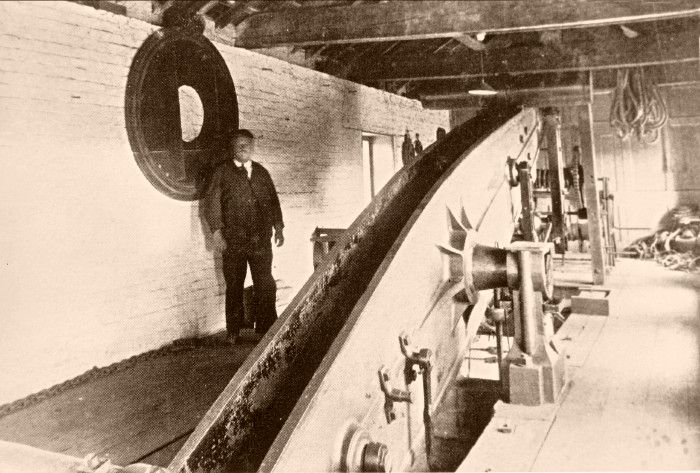
The beam of the Little Tring steam pumping
engine, replaced by electric power in 1927.
By the early 1930s, the Central Electricity Board had been set up
and many of the hundreds of small power generators were being replaced
by larger more efficient power stations (the Aylesbury Electricity
Department ceased to generate electricity in 1934, taking its supply
from the power station at Luton). The reliability of the supply
was further improved when, in 1938, the National Grid was completed
linking all key power stations nationwide. [12]
As for street lighting in Tring, during 1927 the Town Council experimented with a mix of gas and electric
street lighting. The annual cost of lighting by this means came
out at £419 2s 6d compared with an estimated cost of £366 for lighting the
entire district by electricity. Thus, at their meeting in
July 1928 the Council unanimously resolved to light the entire district
with electricity.
Tring Council’s Lighting Committee has long disappeared together with
our town’s gasworks. Today, Council Tax pays for street lighting
while Hertfordshire County Council Highways Department maintain the 115,000 streetlights in the county. All
streetlights, lit bollards and lit signs on major traffic routes are
inspected at night, at least monthly, except on roads intended for local
traffic ― which form some 60% of the UK’s roads ―
where the Department
relies on the public to report faults.
――――♦――――
APPENDIX 1
NOTES ON THE COMMERCIAL PRODUCTION OF COAL GAS
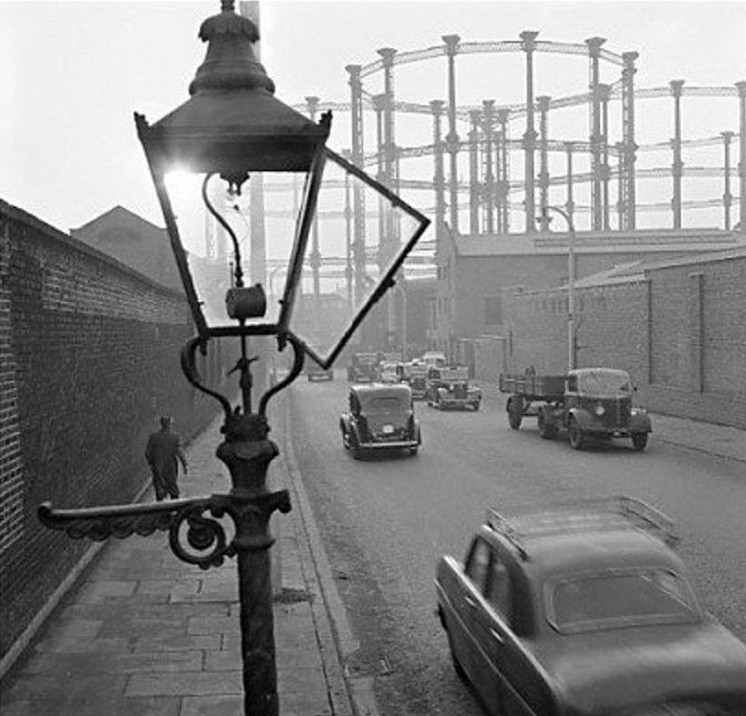
A typical gasworks vista of the 1950s.
“The processes carried on at gas-works have never occupied a very
favourable place in public opinion. The popular notions respecting
them have so long been associated with dirt, and smoke, and disagreeable
odours, that it is not an easy matter to displace these deeply-rooted
prejudices. We make no attempt to disprove, nor do we offer any
apology for, what has been very unpleasantly forced upon the attention
of those who have resided in the vicinity of gas establishments.
It is perfectly true that, through the habitual neglect of what we hold
to be an important part of a manager’s duties, the accusations relating
to dirt and offensive odours have too often been justly merited . . . .”
The Manufacture and Distribution
of Coal-Gas, Samuel Clegg (1866)
Frederick Winsor, a German, gave the first public exhibitions of gas
lighting in Britain, his aim being to promote the idea of building
centralised (as opposed to on-site) gasworks and pumping gas through
pipes to light the streets. Thus was founded the London and
Westminster Gas Light & Coke Company (from which British Gas plc
is descended), which was incorporated by royal charter in April 1812 to
become the first coal gas manufacturing plant designed as a public
utility. The Company proceeded to spread gas lighting through
London’s poorly lit streets. Their engineers, Samuel Clegg and
John Malam, were responsible for several early inventions aimed at
purifying coal gas and measuring its users’ consumption accurately.
The Gas Light & Coke Company was soon followed by other gas
utilities, the first to open outside London being at Liverpool, Exeter
and Preston, all in 1816. It is said that by 1821 no town or city
in Britain with a population exceeding fifty thousand was without gas
lighting.
In the manufacture of town gas, a fuel, generally coal (wood, oil or coke could also be used),
provided the raw material and to minimise the
cost of delivering large quantities, gasworks were often sited
adjacent to canals, rivers or railways. Gas was extracted from the
coal by baking it in enclosed ovens called ’retorts’ in which the coal
was starved of oxygen to prevent it burning. This process produced
a crude gas that contained a number of chemical components including
hydrogen, methane and ethylene, together with unwanted substances such
as sulphur that needed to be removed by a purification process before
the gas could be released into the mains for domestic and commercial
use.
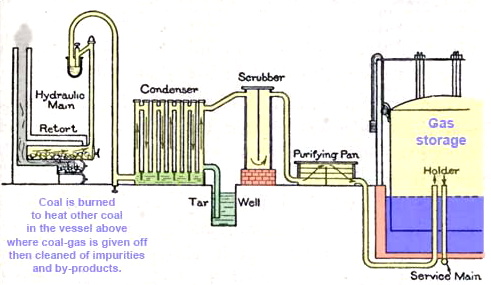
Schematic of a typical small gasworks.
The hydraulic main is a water
-filled airlock that prevented blowback of
explosive gas into the retorts
when a door is opened for recharging.
Other by-products produced during coal gas manufacturing were useful and
could be sold. These were coke (used in large quantities by
the iron and steel industries), ammonia (sulphate of ammonia is a
fertiliser), phenol (carbolic acid, a disinfectant) and coal tar.
In its turn coal tar yielded many other organic products such as
synthetic dye, creosote and drugs (e.g. aspirin) which are now produced
from natural gas or petroleum. When motor vehicles arrived and
measures had to be taken to seal road surfaces to prevent dust and mud
being thrown up by this new, faster-moving traffic, coal tar mixed with
granite chippings became a popular road-surfacing material.
A typical gasworks was divided into several sections for the production,
purification and storage of coal gas.
RETORT HOUSE: this contained
the retorts in which coal was heated to generate the gas. The
crude gas was siphoned off and passed on to the condenser. The
waste product left in the retort was coke. In many cases the coke
was then burned to heat the retorts or sold as smokeless fuel.
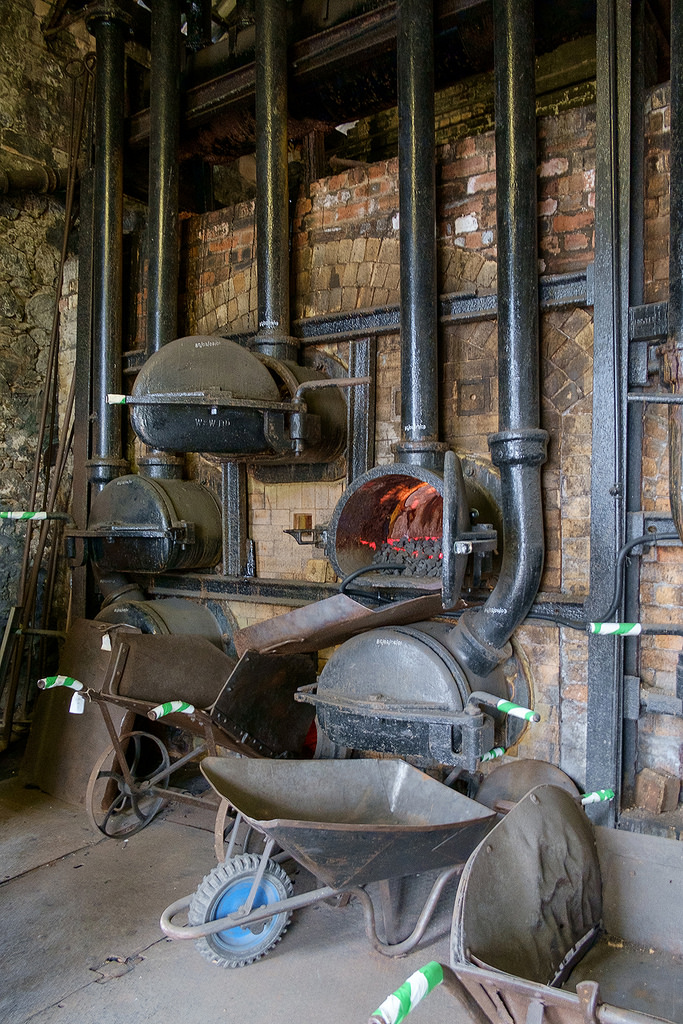
Inside a retort house.
|
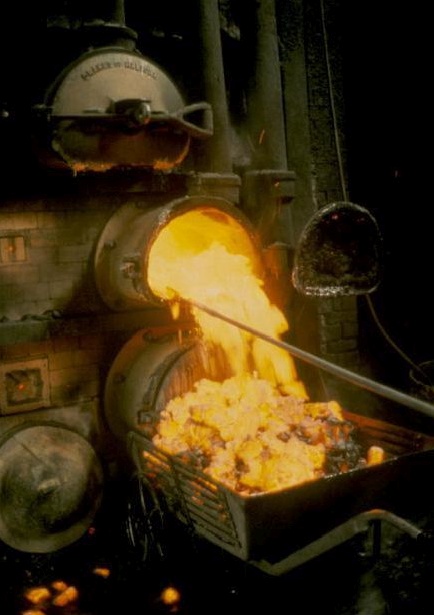 |
|
Emptying hot coke from a retort. |
CONDENSER: this consisted of a bank of air-cooled
gas pipes over a water-filled sump. Its purpose was to remove tar
from the gas by condensing it out as the gas was cooled.
Occasionally the condenser pipes were contained in a water tank similar
to a boiler but operated in the same manner as the air-cooled variant.
The tar produced was then held in a tar well/tank which was also used to
store liquor.
EXHAUSTER: an impeller or pump used to increase
the gas pressure before scrubbing. Exhausters were optional
components and could be placed anywhere along the purifying process but
were most often placed after the condensers and immediately before the
gas entered the gas holders.
SCRUBBER: a sealed tank containing water through
which the gas was bubbled. This removed ammonia and ammonium
compounds. The water often contained dissolved lime to aid the
removal of ammonia. The water left behind was known as ammonical
liquor. Other versions used consisted of a tower, packed with
coke, down which water was trickled.
PURIFIER: also known as an Iron Sponge, this
removed hydrogen sulphide from the gas by passing it over wooden trays
containing moist ferric oxide. The gas then passed on to the
gasholder and the iron sulphide was sold to extract the sulphur.
BENZOLE PLANT: often only
used at large gasworks sites, a benzole plant consisted of a series of
vertical tanks containing petroleum oil through which the gas was
bubbled. The purpose of a benzole plant was to extract benzole
from the gas. The benzole dissolved into the petroleum oil, which
was run through a steam separating plant to be sold separately.
GASHOLDER: often incorrectly called a ’gasometer’,
this was a tank used for storing gas and maintaining even pressure in
distribution pipes. The gas holder usually consisted of an
upturned steel bell contained within a large frame that guided it as it
rose and fell depending on the amount of gas it contained.
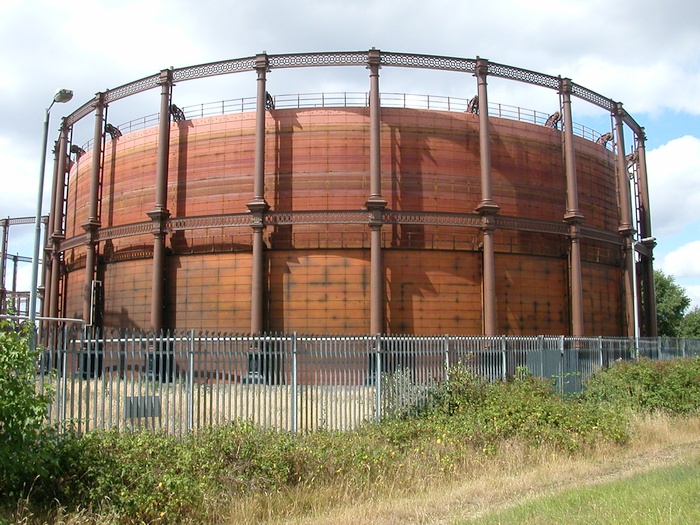
A gas holder, once a common site in the
urban landscape.
――――♦――――
APPENDIX 2
THE AYLESBURY GAS COMPANY.
ITS SLOGAN “SERVICE AND PROGRESS.”
Taken from the Centenary Edition of the Bucks Herald, 1932
Two years after the birth of the “Bucks Herald,” or, to be precise, on
May 23rd, 1834, the original Gas Company was founded to supply the town
of with gas.
There are no records to show who were the first Directors, but at a
meeting of the shareholders held on August 29th, 1861, it was decided to
form a Joint Stock Company to be called “The Aylesbury Gas Company,
Limited.” The Chairman at that time was Mr. David Reid, and the
Secretary, Mr. H. Hatten. Mr. Hatten was one of the promoters in
1834. The new Company came into being on October 2nd, 1861, with a
capital of £10,800, for the purpose of lighting the parish of
Aylesbury-with-Walton with gas. At this time gas was used almost
wholly for lighting by means of self-luminous flames. Mr. David
Reid was Chairman of Directors; Mr. J. K. Fowler was Treasurer; Messrs.
H. Hatten and Joseph Parrott were Joint Secretaries and Solicitors; and
Mr. T. Field was Works Superintendent. The annual make of gas was
10½ million cubic feet.
The make of gas gradually increased year by year, and in 1877 Mr. George
Lane joined the Company as Manager, when the make of was 19½ millions.
In 1883 gas cooking stoves were supplied to consumers on simple hire.
In 1834 Mr. Frederick B. Parrott was elected Secretary in succession to
his father, Mr. Joseph Parrott, and in 1897 Mr. Francis G. Parrott
succeeded Mr. Frederick, and in 1907 he was succeeded by Mr. Francis H.
Parrott.
The advent of the incandescent mantle was thought to be a mixed
blessing, as it was anticipated that the sales of would fall owing to
the extra light given by the mantle. This proved to be otherwise,
as more people used gas for lighting and cooking.
In the year 1901 a new process of making was introduced, namely, a
carburetted water plant, which enabled the Company to postpone the
erection of another gasholder for storing the gas.
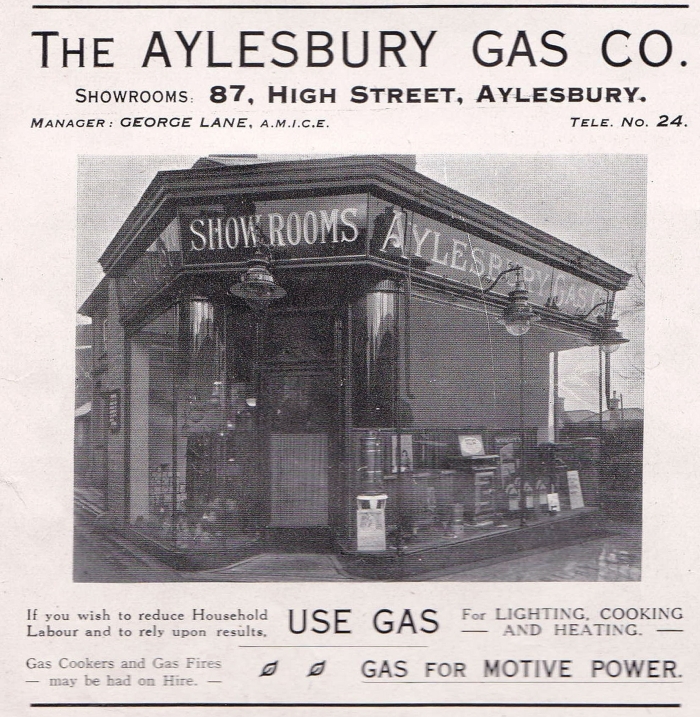
An undated picture of the Aylesbury Gas Showrooms.
George Lane became Manager of the Aylesbury
Gas Company in 1877 and remained in that role until he retired in 1920,
being superseded by his son.
In 1904 it was decided to dissolve the Company and re-incorporate it as
a statutory undertaking, and in 1905 an Act of Parliament was passed
giving the Company power to raise capital to the amount of £90,000 and
to supply gas to the villages of Bierton, Stoke Mandeville and Aston
Clinton. At this period, owing to the demand for gas the large
gas-holder had to be built and the manufacturing plant enlarged, the
annual make of gas being 50½ million cubic feet.
From this time there was a steady increase in the sale of till 1918,
when it became necessary to build a more up-to-date method of making
coal gas. Vertical retorts were installed, and in 1921 the Company had
to seek further powers to purchase the Wendover Gas Company and supply
gas on the therm basis instead of “candle power." The plant at Wendover
was dismantled and supplied by a new main from Aylesbury.
The general strike in 1926 was the worst period the Company has
experienced. The foreign coal which had to be used badly damaged the
manufacturing plant, causing unnecessary repairs, and over £4,000 had to
be paid extra for coat during this time. The old carburetted water gas
plant had to be replaced by the latest type of plant, which, although
occupying the same space, is capable of making three times more gas. The
Company managed to “weather” the storm, however, and is still making
progress, especially in cooking and heating. Over 700 cookers have been
sold during the last five years.
It is interesting to note that owing to the long lengths of main
necessary to supply the districts, only three million cubic feet of gas
is used per annum on each mile of main, compared with some London
Companies, where, with more houses, the consumption is as high as eight
or nine million cubic feet.
The rates and taxes paid in 1861 were only £40, compared with £1,500 at
the present time.
The annual make of gas is now 92 million cubic feet.
Although 98 years old, the Company is still in “Service” and in step
with “Progress."
Mr. G. Ball, the Chairman, has been a Director for 23 years.
Mr. J. H. Coales, the Secretary, succeeded Mr. F. H. Parrott in 1917,
when Mr. Parrott became a Director.
Mr. Frank Mitchell, the Genera! Manager, was appointed in 1926.
――――♦――――
APPENDIX 3
AYLESBURY’
S ELECTRICITY UNDERTAKING.
Taken from the Centenary Edition of the Bucks Herald, 1932
The municipally-owned electricity undertaking of Aylesbury is one phase
of local commercial activity upon which the town has reason to be justly
proud. its advancement and expansion since its inception in 1915 has
been such as to make Aylesbury a by-word in the electrical world, both
in this country and abroad. It has also given the Aylesbury
Corporation the distinction of being pioneers of rural area
electrification, a movement which, under the aegis of the Electricity
Commissioners, has now been extended to all parts of the British Isles.
Moreover, the Aylesbury undertaking was the first to experiment with and
adopt the use of tar oil with Diesel engines, this step being taken
during the war in an endeavour to restrict the consumption of oil
transhipped from America. The steel transmission lines which take
the current to the countryside surrounding Aylesbury, and what is known
in the trade as the Aylesbury pole, both of which have come into
much-favoured use far and wide, also are the innovations of the
Aylesbury undertaking and of Mr. W. A. Turnbull, who has been the
Borough Electrical Engineer throughout.
Some idea of the increasing demand upon the Aylesbury undertaking can be
gauged from these facts. The original capital was £21,000, and it
is now over a quarter of a million pounds; the units sold increased from
a quarter of a million in 1915 to two million in 1924 and to eight
million to-day; when the war ended the consumers numbered 250, and now
they total 7,445; and at the present time 1,158 cookers, 1,700 kettles,
762 fires, 2,080 irons and other apparatus are on hire from the
Electricity Department, in addition to what is owned by the consumers
themselves.
Yet in 1914 the establishment of the undertaking literally lay in the
balance. Just before the outbreak of the war the Council placed
the necessary contracts. The machinery was being made when war was
declared, and the Council debated the wisdom of proceeding. They
decided to go on, however, and the contracts were completed at pre-war
prices. The works in Exchange Street were erected for the purpose
of the new undertaking.
The generation of electricity actually began in May, 1915, but it was
not till some months afterwards, when several Aylesbury factories were
being devoted to the manufacture of war material, that the demand showed
any definite increase. Then the two original Diesel engines became
fully loaded, so much so that the factories were asked to cease using
current by day and to resume by night. Towards the end of 1916 an
application to extend the plant was made and a Class A certificate by
the authorities was granted, in view of the importance and urgency of
the war work being carried out in the Aylesbury factories. This
extension took the form of a suction gas engine, which offered the
additional advantage that it did not consume the oil which was being
shipped from overseas. When it began running, early in 1918, it
was immediately loaded up and the works were generating current to their
utmost capacity throughout the 24 hours of each day.
When, after the war, the Cubitt Motor Works began in the Bicester Road,
there was a sudden, new demand for a vast amount of power. To meet
this a steam turbine plant was introduced, and switched in for the first
time in August, 1920. Unfortunately, that new commercial
undertaking closed down, and the Aylesbury Corporation was left with
surplus electricity plant. To find a new use for this electricity
plant the Corporation sought and obtained the necessary powers to enable
them to take their electricity into the rural area. The first
extension was to Waddesdon Manor in 1924, but extended powers in 1925
enabled them to take their transmission lines over an area of 230 square
miles. With the exception of about six of the smaller villages,
the whole of that area now has current from the Aylesbury Works at its
disposal for all purposes.
An interesting feature of this rural area supply is that it has created
a demand considerably greater than that of the Borough of Aylesbury
itself, and is yielding more revenue. It is not yet fully
developed, because it is as yet only in the constructional stage, but
there are indications that the rural area will early be of very material
assistance to the Borough in relation to its electricity undertaking,
and an important factor in its increasing success.
Every factory in Aylesbury is now connected with the Borough electrical
supply. In the rural area all the larger factories are connected
up, and many smaller factories are failing into line. The variety
of trades catered for is so wide that the electricity undertaking can be
said to be almost depression-proof, for when there is a depression in
one there is certain to be a compensating activity in another.
The increased confidence felt in the ultimate improvement of
agricultural prospects is all to the good of the undertaking, for the
Electricity Committee takes advantage of every new opportunity of
bringing its current to the aid of agricultural operations, in the
belief that an electrically-equipped agriculture will reduce working
costs, increase productivity and preserve the amenities of the
countryside.
――――♦――――
FOOTNOTES
1. Hemel Hempstead’s first gas works became the Hemel
Hempstead Gas & Coke Company in 1845; in 1868 it was reincorporated as
the Hemel Hempstead and Boxmoor Gas & Coke Company. In addition to
gas from this company, the Boxmoor area was also supplied by the Boxmoor,
Two Waters & Crouchfield Gas & Coke Company. In 1873 these
concerns agreed to apportion the district between them, the Boxmoor
Company supplying gas to the south of the Grand Junction Canal. In
1878 they amalgamated by Act of Parliament to form the Hemel Hempstead
District Gas Company, which, in 1931, was acquired by the Watford and St
Albans Gas Company.
2. The Great Berkhamsted Gas Light & Coke Company was
a joint stock company established in 1849 and incorporated by act of
parliament in 1888. It was dissolved by act of parliament in 1905
and reincorporated as the Berkhamsted Gas Company Ltd. Originally
gas was manufactured at a site located at the junction of Water Lane and
the Wilderness, but in 1906 the gas works was moved to a site near
Billet Lane. An 18-inch gauge tramway across Canal Fields at the
rear of South Park Gardens connected the gas works to a railway siding
near the station, horses being used to haul the coal. Following closure
of the gas works in 1959 the town was supplied with gas through a
pipeline from Boxmoor.
3. The meeting at the Commercial Hall (at the rear of
Brown & Merry’s premises) was chaired by Thomas Butcher Jnr., a
member of the family that owned Butcher’s Bank (a.k.a. Thomas Butcher &
Son and The Tring Old Bank) in the High Street, now the premises of the
NatWest Bank. For many years the Butcher family were also
associated with the management of the Tring Gas Light & Coke Company.
4. In 1855 the first Limited Liability Act was passed,
and in 1856 the 1844 and 1855 Acts were amended and consolidated into
the Joint Stock Companies Act 1856. Except for banking and
insurance companies, existing companies (including The Tring Gas Light &
Coke Company) were required to re-register under this Act. The
1856 Act required all registered companies to file an annual return and
is often referred to as the first modern Companies Act.
5. At the time of writing the former gasworks site
is being redevelopment by Lillygate Developments Ltd as a block of
luxury flats. To be named Brookside Apartments, the block will
comprise thirty-four flats with underground parking.
6. We have been unable to trace “Mr. Chadwick”.
It may be coincidence, but an 1861 edition of the Gas Journal
lists Ellis Chadwick as a manager at the Macclesfield Gasworks, the
company for whom Dickinson served as Secretary at the time of his visit
to Tring.
7.
A bushel was
an imperial volume measure equivalent to 8 gallons or 36.4 litres.
A
chaldron was an English volume measure, mostly used for coal, the word
itself being an obsolete spelling of cauldron. The chaldron was
the legal limit for horse-drawn coal wagons travelling by road as it was
considered that heavier loads would cause too much damage to the road
surfaces. There appears to have been no legal standard for the
Chaldron, although in London it approximated to 36 bushels, weighing 25⅓
hundredweights, or about 2837 pounds (1287 kilograms). The Weights
and Measures Act (1835) required all coal to be sold by weight, not by
measure, an injunction repeated in the Weights and Measures Act (1878),
which nonetheless again defined the chaldron at 36 bushels. The
chaldron was finally abolished by the Weights and Measures Act 1963.
8. In the 1851 census, Garnett Jones and Robert Wright
are both listed as living in ’West End’, which described the King Street
area of the Town before the streets were named, but exactly where is
impossible to say. Garnett Jones, 48, was the Relieving Officer
for the Berkhamsted Union and Robert Wright was a butcher. What
became King Street was then known as ’Pleasant Lane’.
9. TRING LOCAL BOARD OF
HEALTH: local boards ― or local
boards of health to give their full title ― were the local authorities
in urban areas of England and Wales from 1848 to 1894. They were formed
in response to cholera epidemics and were given powers to control
sewers, clean the streets, regulate environmental health risks including
slaughterhouses and ensure the proper supply of water to their
districts. Local boards were eventually merged with the corporations of
municipal boroughs in 1873, or became urban districts in 1894.
10. Today we have the extensive ’National Transmission
System’, a network of pipelines that supply gas to power stations from
natural gas terminals situated on the coast, and to gas distribution
companies that supply domestic and other customers. Gas is
injected into the system at the seven UK gas terminals (six in England
and one in Scotland) and various storage facilities. After
crossing the transmission system, gas enters the distribution networks
at high pressure. It is then transported through a number of
reducing pressure tiers until it is finally delivered to consumers.
The gas is owned by the gas suppliers, but the National Grid is
responsible for it whilst it is being transported.
11. In 1930 there were just under 1,800 gas and coke works
and coal carbonisation plants. By 1935 this figure had fallen to
1,514, of which 1,395 were gas works; 40% of the establishments employed
less than 10 people, and 55% employed 11-300 people. When the Gas
Council was formed following nationalisation in 1949, there were about
1,050 gas works and , by 1958, only 536. The last gasworks closed
in 1981, an isolated lone gasworks in Millport on the Isle of Cumbrae
(also known as Great Cumbrae, lies on the Ayrshire coast and is roughly
4 miles long and 2 miles wide). Sites ranged from smaller works,
producing town gas only to large sites where coke production may have
been the main process or where tar distillation or other associated
processes were undertaken in addition to gas production. Site
sizes may range from as little as 0.3 hectares to over 100 hectares.
12. In 1925, Lord Weir chaired a committee that
proposed the creation of the Central Electricity Board (CEB) to link the
UK’s most efficient power stations with consumers via a ’national
gridiron’. The United Kingdom Central Electricity Board was set up
under The Electricity (Supply) Act 1926 to standardise the nation’s
electricity supply. At that time, the industry consisted of more
than 600 electricity supply companies and local authority undertakings,
and different areas operated at different voltages and frequencies
(including DC in some places). The Board’s first chairman was
Andrew Duncan.
The CEB established the UK’s first synchronised AC grid running at
132,000 volts and 50 Hertz, which by 1933 was a collection of local
grids (with emergency interlinks) covering most of England. This
started operating as the National Grid in 1938. The CEB ceased to
exist when the grid was nationalised by the Electricity Act 1947 and
taken over by the British Electricity Authority.
――――♦――――
[Next page]
 |